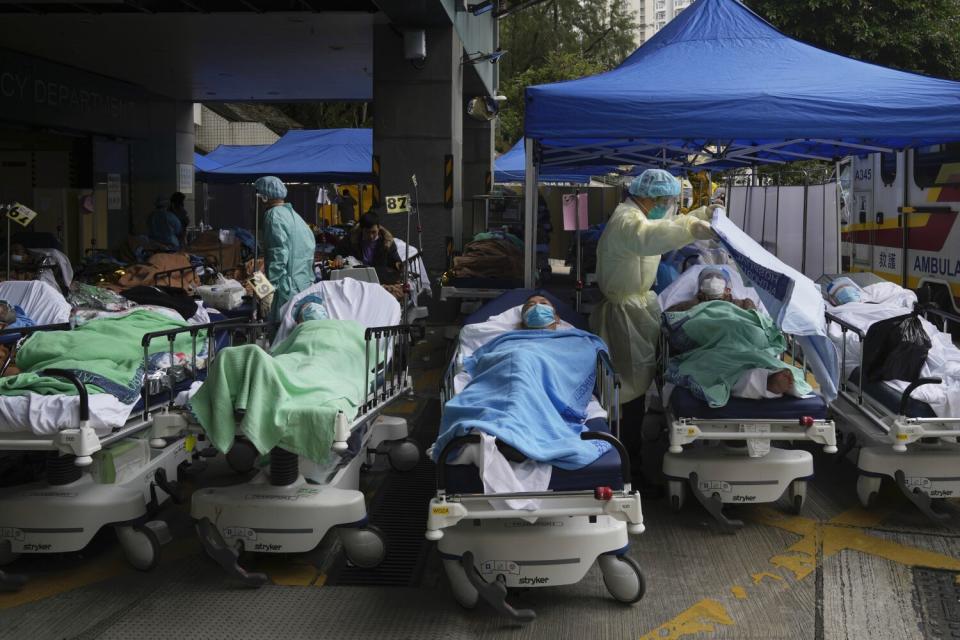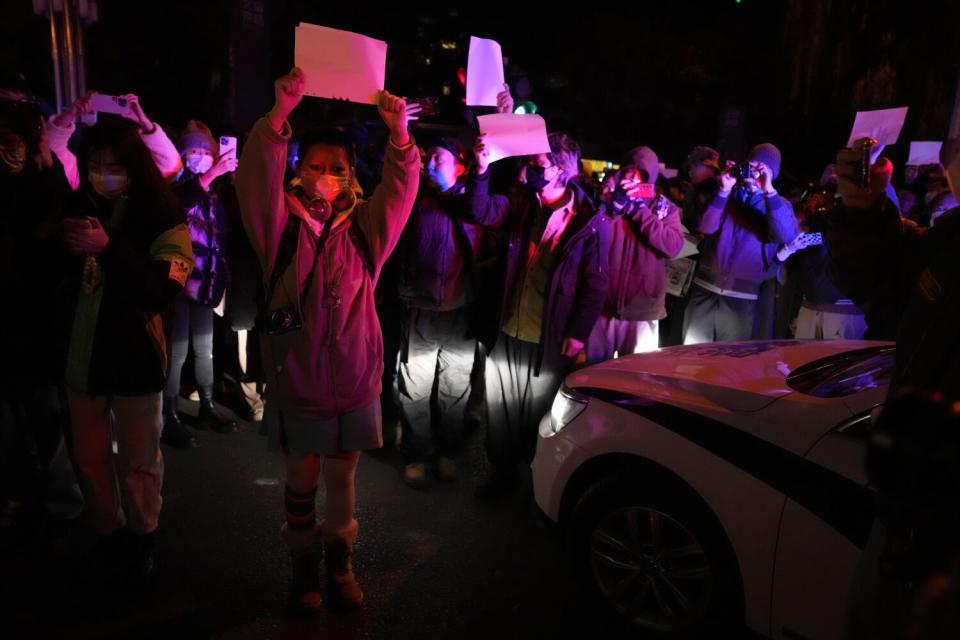'Zero COVID' is roiling China. But ending the policy may cause a massive health disaster

Nearly three years into a pandemic that has killed more than 6.6 million people worldwide, the official death toll in mainland China stands at 5,233 — a stunningly low number for the world's most populous nation.
While most countries long ago stopped trying to eliminate the coronavirus and decided to live with it instead, China has gone to extreme lengths to prevent it from spreading. The government relentlessly tracks its citizens, mandates constant testing, shutters workers inside factories and locks down entire cities under a plan that has come to be known as “zero COVID.”
Now, with China's economy in steep decline and protesters taking to the streets in a rare show of defiance against an authoritarian government, the country’s leaders are facing enormous pressure to ease up on those restrictions.
But there’s a major problem they’ll have to contend with: Zero COVID has turned China into a coronavirus tinderbox.
With outbreaks scrupulously suppressed and vaccination rates lagging, the population is likely to have little natural immunity. If the rules were relaxed too much, experts fear the country of 1.4 billion would experience a public health emergency on a massive scale, which would threaten its capacity to care for the sick.
“Without a coordinated and coherent plan, it might just lead to a rapid increase in cases, and then you will find the healthcare system quickly overwhelmed,” said Yanzhong Huang, senior fellow for global health at the Council on Foreign Relations and an expert on public health in China. “That will defeat the very purpose of the Chinese pandemic response.”
To get an idea of what that could look like, consider Hong Kong in February. That’s when the highly contagious Omicron variant broke through the city’s zero-COVID defenses and swept through the densely packed metropolis.
Although 72% of residents had been vaccinated against COVID-19, vaccine uptake among vulnerable senior citizens was considerably lower. Less than 45% of those 70 and older were inoculated when the outbreak got underway, and among residents of assisted-living homes, it was below 20%.
Within weeks, a massive convention center was transformed into a makeshift hospital to care for elderly COVID-19 patients. Wait times for ambulances lasted up to two days. Morgues ran out of coffins as the daily death toll soared from zero to nearly 300 even though the variant often seems less dangerous than its predecessors.

Public anger and frustration aside, many citizens fear a similar scenario could unfold on the mainland.
“Society is very divided,” said Xi Chen, a health policy expert at the Yale School of Public Health. “They worry about too-harsh lockdown measures, but they also worry about the government relaxing everything.”
When the novel coronavirus first turned up in Wuhan in late 2019, Chinese officials were slow to recognize the threat. But once the risk became clear, the country implemented sweeping measures to stamp out viral transmission. That meant canceling international flights, blocking highways and confining entire city populations to their homes.
Within months, life in China had returned to normal while countries such as the U.S., South Africa and Brazil struggled to keep their death tolls under control.
President Xi Jinping has trumpeted zero COVID as one of his crowning achievements, calling it proof that China’s governance is superior to those in the West. For a long time, it looked like he was right, said Michael Osterholm, director of the University of Minnesota’s Center for Infectious Disease Research and Policy.
“Then came Omicron,” Osterholm said. “Earlier variants were like severe forest fires: They were challenging, but they could be contained. Omicron is like the wind. They can divert it. But they can’t stop it.”
Chinese officials have certainly tried.
Authorities require daily or near-daily coronavirus tests to immediately identify infections. Single-digit case counts have prompted protracted lockdowns. As new cases reached record levels, 95 out of China’s top 100 cities by economic output have implemented COVID restrictions as of Nov. 22, according to Beijing-based research firm Gavekal Dragonomics.
Under the most severe lockdowns, citizens have struggled to get adequate supplies of food and medicine. The measures have also dragged down the economy, shutting businesses, disrupting factories and stifling consumer spending.
The government continues to tout the country’s low death count, which doesn’t include Hong Kong. Though the official tally is a subject of debate, experts agree that China’s COVID-19 death rate remains one of the lowest in the world.
But that success has done little to quell the growing outrage. For many, the costs of such a unyielding policy has been crystallized by events such as a bus crash in the southern province of Guizhou that killed 27 people who were being transported to a quarantine facility under zero COVID. Or the fact that anxious residents of Sichuan province were barred from leaving their apartment buildings after an earthquake that killed at least 93 people. Or the death of a 3-year-old boy in Gansu province who succumbed to carbon monoxide poisoning after health workers enforcing a lockdown prevented his father from calling an ambulance.
The last straw was an apartment fire that killed 10 people last week in Urumqi, the capital of the Xinjiang region that has been under lockdown for more than three months. Angry citizens believed zero-COVID controls prevented residents from fleeing and kept firefighters from reaching the burning building in a timely manner.
Over the weekend, vigils for the Urumqi victims erupted into mass demonstrations across the country, with many participants complaining about China’s zero-COVID policy and even the Communist Party and President Xi.

Though the government moved to quickly quell the protests, there are signs the public dissent has put more pressure on party leaders to come up with a zero-COVID exit plan.
Exactly what that would entail is unclear, but authorities reemphazised one major priority Tuesday: boosting the vaccination rate among the elderly. While 90% of Chinese people were fully vaccinated as of mid-November, the National Administration of Disease Prevention and Control says only 66% of those 80 and older have been fully vaccinated, and only 40% have gotten a booster even though doses are widely available.
Increasing immunity among senior citizens is vital because they are the most vulnerable to serious illness with COVID. In Singapore, for instance, 99% of pandemic deaths have occurred in people over age 60. In England, that age group accounts for 92% of fatalities.
Vaccine skepticism has been widespread among seniors across China since the shots first came out, said Winnie Yip, director of the China Health Partnership at Harvard’s T.H. Chan School of Public Health. She traced that to the fact that the country’s first two homegrown COVID-19 vaccines were available only to adults younger than 60.
“The general perception that the government gave people was, ‘We’re not so sure about the vaccine yet, so maybe older people shouldn’t take it,’” Yip said. “Older people in general feel that because they’re older, they should not be subject to the risk of the vaccine.”
Nor can China count on citizens having much immunity from past infections. The country’s frequent coronavirus testing and use of mobile health codes that record travel history and close contacts identify people with asymptomatic infections before they have a chance to spread the virus too widely.
The result is that if China’s harsh zero-COVID restrictions are lifted, the healthcare system could be overwhelmed with patients in need of hospital beds. The country has about 4 intensive care beds per 100,000 people, according to study estimates and official comments. That compares with 27 ICU beds per 100,000 people in the U.S., according to the Kaiser Family Foundation.
Even offering a little slack under the current conditions could allow things to quickly spiral out of control. During an Omicron-fueled outbreak in Shanghai in the spring, a trial run of looser restrictions led to swamped hospitals and elderly care facilities, prompting a two-month lockdown of the city of 25 million. Residents confined to their homes complained of dwindling food and medical supplies, while others were forced to spend weeks in quarantine facilities, at times causing parents to be separated from their children.

“Cities are now in a bit of a dilemma, because they want to use a softer hand, but that’s not working,” said Ben Cowling, an epidemiologist at the University of Hong Kong.
Until China increases its vaccination rate for seniors, improves the efficacy of its vaccines and treatments and bolsters its medical resources, it cannot afford to loosen its grip on zero COVID.
“If they had one of those three things in place, that would shift the risk calculus tremendously,” said Andy Chen, lead COVID analyst at Beijing-based consultancy Trivium China.
But for now, China lacks all three.
Yang reported from Taipei and Healy reported from Fairfield, Conn. David Shen of The Times’ Taipei bureau contributed to this report.
This story originally appeared in Los Angeles Times.

